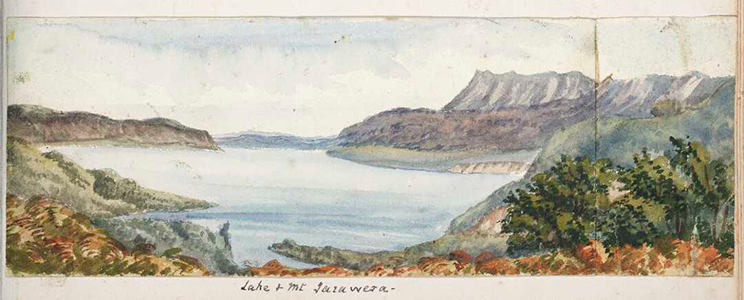
Artworks on Paper
A guide to caring for works of art on paper, including watercolours, pencil sketches, etchings, and lithographs.
What’s an artwork on paper?
Artworks on paper may include original works in media such as watercolours, inks, pencil and charcoal, or prints, such as etchings, engravings and lithographs.
Handling
Never touch the surface of a picture. Paper easily absorbs skin oils and perspiration so wash your hands before handling any type of valuable artwork.
When handling unframed artworks, use both your hands, and support them from underneath or place them in a folder. When carrying a framed work, hold both sides of the frame.
Don't use pressure-sensitive tapes such as Sellotape or masking tape, or adhesives such as PVA (white glue) or rubber cement to mend or mount an artwork. If cleaning or mending is necessary, get advice from a conservator who is a member of the New Zealand Professional Conservators' Group.
Storage
Pictures in storage should be kept in a dark, clean, dry location with adequate air circulation. Temperature and humidity levels should be moderate and constant.
Ideally, unframed pictures should be matted and stored flat. Loose items may be kept in folders and interleaved with acid-free tissue paper to separate them from each other and to protect the surfaces from abrasion.
Works with a fragile or delicate surface, such as unfixed charcoal or chalk drawings, should not be kept in folders. Anything touching the surface of these works could damage them. Framing provides the best protection for these items.
Framed works in storage should not rest directly on the floor. If shelving is not available, raise the frames off the floor by resting them on padded blocks.
Avoid rolling oversized artworks. If this is the only option, roll the artwork onto a large diameter tube covered with an appropriate barrier layer of archival material (eg Tyvek or Mylar). Use an interleaving material, such as acid-free tissue, to cover the artwork before rolling it around the tube, to stop two parts of the work from touching each other directly once rolled.

Lake & Mt Tarawera, by Gertrude Yarborough, 1882. Ref: E-881-f-051-3. Alexander Turnbull Library.
Matting and Framing
Artworks should be matted and framed for display.
Matting
The mat is an enclosure made up of a window mat hinged to a backing board. The mat supports, protects and isolates the artwork. The frame (with glazing) provides protection from physical damage, dirt, dust, smoke and accidental spatters.
Poor quality matting and framing is a major risk to artworks. For long-term protection, matting and framing should be done to "conservation", 'archival' or "museum" standards. This means the artwork is attached to the backing board in a safe and appropriate manner, and the materials used are of good quality and will not cause damage to the artwork over time. Not all commercial framers provide this type of service. Note that the materials required are more expensive and the work takes extra time and care.
The matboard used should be acid-free and alkaline-buffered. Artworks should be attached to the backing board with paper hinges or corners, never glued directly onto a cardboard backing. Neither should the window mat be adhered directly to the artwork.
Framing
The frame should be larger than the artwork to allow for expansion and contraction of the paper with changes in humidity. There should be no direct contact between the artwork and the inside of the glass. The window mat, or alternatively a spacer incorporated into the frame, will stop the artwork from touching the glass.
Frames can be fitted with glass or Perspex. Perspex is unbreakable but does scratch quite easily. It is also more expensive than glass. Artworks with loose, powdery media should be framed with glass as Perspex has a static charge that may attract media particles away from the paper.
Cleaning framed artworks
Never spray the cleaning solution directly onto the glass of a framed picture. It can run between the frame and glass, be absorbed by the paper and cause staining. Spray the cleaner onto a cloth, then wipe the glass.
Display
Exposure to light can cause discolouration and brittleness in paper and fading of media. Watercolour, gouache and dye-based media such as felt pen and coloured inks are particularly light-sensitive.
To protect your artworks:
Keep lighting to a minimum
Tungsten light bulbs provide a less damaging type of light than fluorescent or natural light sources.
Do not use frames with clip-on light fixtures. These create 'hot spots' which can dry out the paper.
Do not display pictures near sources of heat or moisture.
Avoid hanging artworks on external walls (as these can be damp) or above the fireplace.
Use closed hangers or crimp the hanging hook closed to help prevent the artwork from falling in an earthquake.
Dust frames regularly. Check the backs of framed pictures periodically for dirt, dust, signs of mould or insect activity, and to ensure that hangers and hardware are secure.
Need help?
You can get professional advice and assistance in caring for your artwork from the National Preservation Office.
Email — preservation@dia.govt.nz
Phone — 04 474 3000
Further information
Related content

Books
Careful handling and proper storage can extend the life of your books, whether they are family heirlooms or modern publications.
Help from the National Preservation Office
Find out how the National Preservation Office can help you. There is also a list of other conservation organisations and services that may be of assistance.Feature image at top of page: Detail of Lake & Mt Tarawera, by Gertrude Yarborough, 1882. Ref: E-881-f-051-3. Alexander Turnbull Library.